When Disneyland reopens to the public Friday, the park also will debut the latest revamp of its Snow White ride, now called Snow White's Enchanted Wish.
For insight into why Disneyland decided to change its Snow White ride, as well as what fans can expect when they visit, I spoke last week with Dave Caranci, manager of creative development, Walt Disney Imagineering, who helped oversee the project. Fair warning, spoilers ahead.
Robert: Of all the things WDI could change at Disneyland, why Snow White? And why now?
Dave: Snow White is the only princess attraction in Disneyland Park. So we've got princess meet and greets and we've got different things like that, but it's the only attraction. And yet it's not an attraction that really tells a story about our princess. If Fantasyland is the heart of Disneyland, and princesses are the heart of our storytelling, we don't even have a good story that tells about our very first princess. So that was the first thing we started thinking about.
The second thing was that we looked at the attraction for relevancy and [asked], are the current story points in there relevant? Are they good story points that we want to tell, or can we tell a better story?
The third thing was we had an intern at the time [David Borning] who had a passion for Snow White. Because it was coming upon the 80th anniversary of Snow White, he went home and built a little model and then came back the office and really sold us on the idea of, what if we enhance Snow White and we did some cool new things to it? That really got us thinking, and it got it got legs very fast and became a project. That's how Snow White's Enchanted Wish came to life.
Robert: There's a lot to unpack there, but the first thing that jumped out at me was that this idea came from an intern. Most places I've been at, the only the only decision the intern gets to make was do you get the medium or the small coffee to bring back.
Dave: Well, he was actually part of our Imaginations program at Imagineering, and you know that's a program where they bring in a lot of people and they have a couple of months to do some really cool projects and pitch them, and I had him interview with me, and I said you should come down to Anaheim and work with us for a while as an intern because I really liked what you do - I like the way you think. And he just fit right in.
Robert: Tell me a little bit about your experience with Snow White. What's been your interest in this - is this something that you've always been a fan of, or is it something you just came to once David came in with the project?
Dave: I've always loved Snow White. I've always loved it as the classic first animated feature, and I've always loved the music, but personally I always felt like the attraction didn't give it justice. As the attraction became older, and we become more sophisticated, as I would ride it, it really felt like it was lacking the charm that the movie had and that we as Disney could do better. So when I saw this guy's model, I was very interested in what could we do - what kind of special effects, what kind of new projection mapping, what kind of new animation could we bring in, so it still felt very classic - we don't want to take away the legacy attraction feel of it - but also felt like it fit today.
Robert: Snow White is an absolutely fascinating story. First of all, there's the history of it. I mean, obviously, you think of Disney you think of Mickey Mouse. He is the brand ambassador. But, frankly, a lot of studios had animated characters and were doing great with shorts back in the 1920s and 30s. But Snow White, I would argue, is as much the foundation of The Walt Disney Company as we know it today as Mickey Mouse, because that was the first animated feature. No one else did that. That's what made Disney, Disney. So there's real historical relevance for this attraction - more than any other Disney IP. This is the first of all those animated features. What kind of stakes does that create for WDI and for Disney in treating this attraction within the parks?
Dave: That's a great question. Firstly, one of the things I was going to mention, it always saddened me when I've walked through Fantasyland and Peter Pan had a two-hour wait, and Snow White had ten people in the line.
Robert: Well, there's capacity.
Dave: I just felt like there's got to be something we could do to drive people to this attraction. First, we have a Walt legacy attraction - an opening day 1955 attraction - that we have to be very careful with. Our guests, whether they ride it or not, they love the fact that it's there. They may never ride it, but don't ever change it, right?
The other thing is we've got a brilliant movie that's so artistically done, that is a milestone within movie making, that we have to be careful that we're treating it correctly. And so a lot of those thoughts went into the decisions we made about how we were going to treat this enhancement.
We really love balancing of classic attractions - the way that we put people into a three-dimensional world, a very theatrical world, versus a lot of digital projection, a lot of special effects. Now we did do all of that, but it was how were we going to do that to blend it, so that it didn't feel like we were taking it out of that beautiful classic imagery that Walt had created, which was so important.
Some of the digital projection we have, we actually went back to the movie and rotoscoped out what we wanted and digitally mapped that in the room. So the projection is part of the original movie, rather than going into a computer and CGI'ing the work so that doesn't feel like that fits anymore. It would feel like it's a different art form. So we were able to blend three-dimensional painted sets and three-dimensional sculpted characters now with projected imagery that was all artistically in the same family.
That was the first thing we did. The second thing, we decided not to do anything with projection heads. That has a place and I happen to really love it in Frozen at Epcot. But it didn't feel right for here. That technology felt like, again, we were taking the art form out of the tradition of Snow White.
Then we were able to bring back a sculptor [Theresa Miller] who had retired years ago - I think she'd been with the company almost 40 years. We were able to bring her back to do some of our Dwarves and animals. She's an on-model sculptor and did them exactly like the movie, which was phenomenal. So all of that was really, really important to us. Then ultimately came the blacklight paint, and we have a blacklight superstar genius on our team who's been doing it for close to 30 years [Jim Crouch]. He does it all over Disney parks in the world, and he oversaw the blacklight paint so it felt like it was within the film.
Robert: Let me let me get back to the issues of story beats and point of view, because I think point of view is a really important issue in Snow White. I don't think of her as a really active protagonist. If anything she's kind of this catalyst - I mean, she literally sleeps through the whole third act.
If I want to blow people's minds, I always tell them that, from Snow White's perspective, the apple worked. She took by the apple, and the next thing she knows, her handsome prince is there to take her to live happily ever after. So much of the action is actually being driven by the Evil Queen and the Seven Dwarves.
As a designer - as you're looking at this attraction and all of these particular points of view that you can be putting the rider in - how did you decide, this is what we need to do to change?
Dave: Well first thing is really looking, like you said, at the beats of the movie. The biggest issue that we had, and we were probably solving for is, if you remember the old attraction, the Queen's trying to push the rock down on the Dwarves. It falls on her. She screams, gets hit by lightning, and then the show doors open as they live happily ever after, and everybody was just like, that makes no sense. What does that even mean? So obviously we had a problem.
We weren't telling a full story. So the first thing we want to do is - and we don't always do this by the way, but in this case, this was our idea - we want to bookend the Snow White story the best we can, so that it all makes sense. So we started looking at key moments, and we did it backwards. We started with the end in mind. All right, they lived happily ever after - what brought them to that?
Obviously, the end scene where she's being carried off into the clouds, into the castle - that's a key moment. Now, we rework that a little bit and I'll talk a little bit more about that, but we wanted that scene in there. We knew that the kissing scene was important. How was she dead? How did she die, and then how was she awoken? So we knew we needed that scene in there.
One key scene we were missing was her biting the apple. If you don't know the story - and a lot of young kids have not seen the movie - all you see is the witch with the apple. Well, okay, then what happened? So, we have another feature that was really important that we add.
We've kept the apple-in-the-cauldron scene, and we've kept the transition scene of the Queen to the hag in, because those are beloved scenes. But we also wanted folks to understand what the Dwarfs did. In the old attraction, we had the Dwarfs dancing in the cottage and playing music, and then it was about the Queen, and then you entered what looked like an abandoned mine, where everybody had left years ago. So what is the mine about again? We can't assume that every guest riding knows the story. We've got to tell the story. That was kind of our idea of how we were going to bookend this.
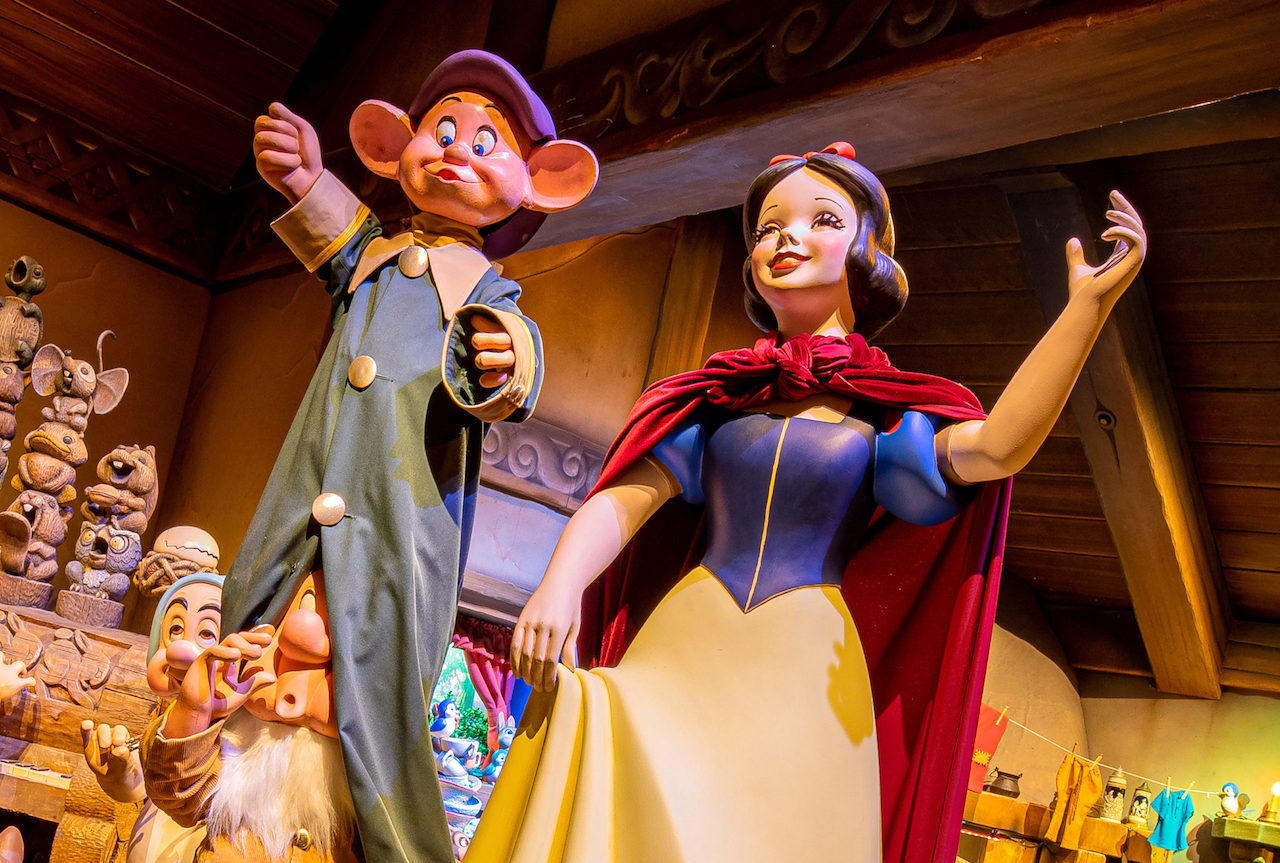
So with that said, we are opening now with Snow White dancing with the Dwarfs. We still see the Queen peering in the window saying, I'll get that Snow White, but now we see the Dwarves marching off to the mine and singing Heigh Ho. When we get to the mine, it actually looks like it's active and we see Dwarves working and we hear them, and we see scopes of Doc and Dopey, and we see Grumpy picking at the world's largest diamond. We see these wonderful effects.
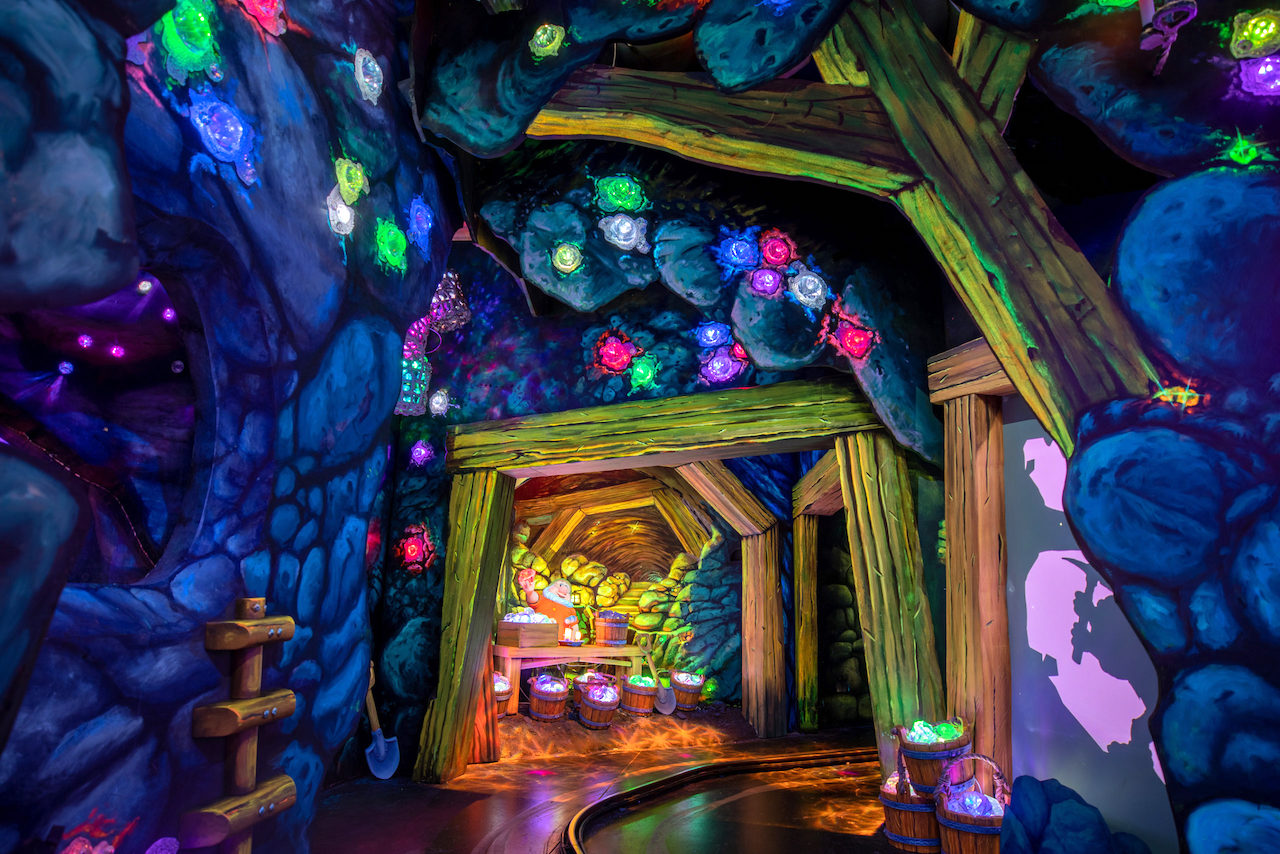
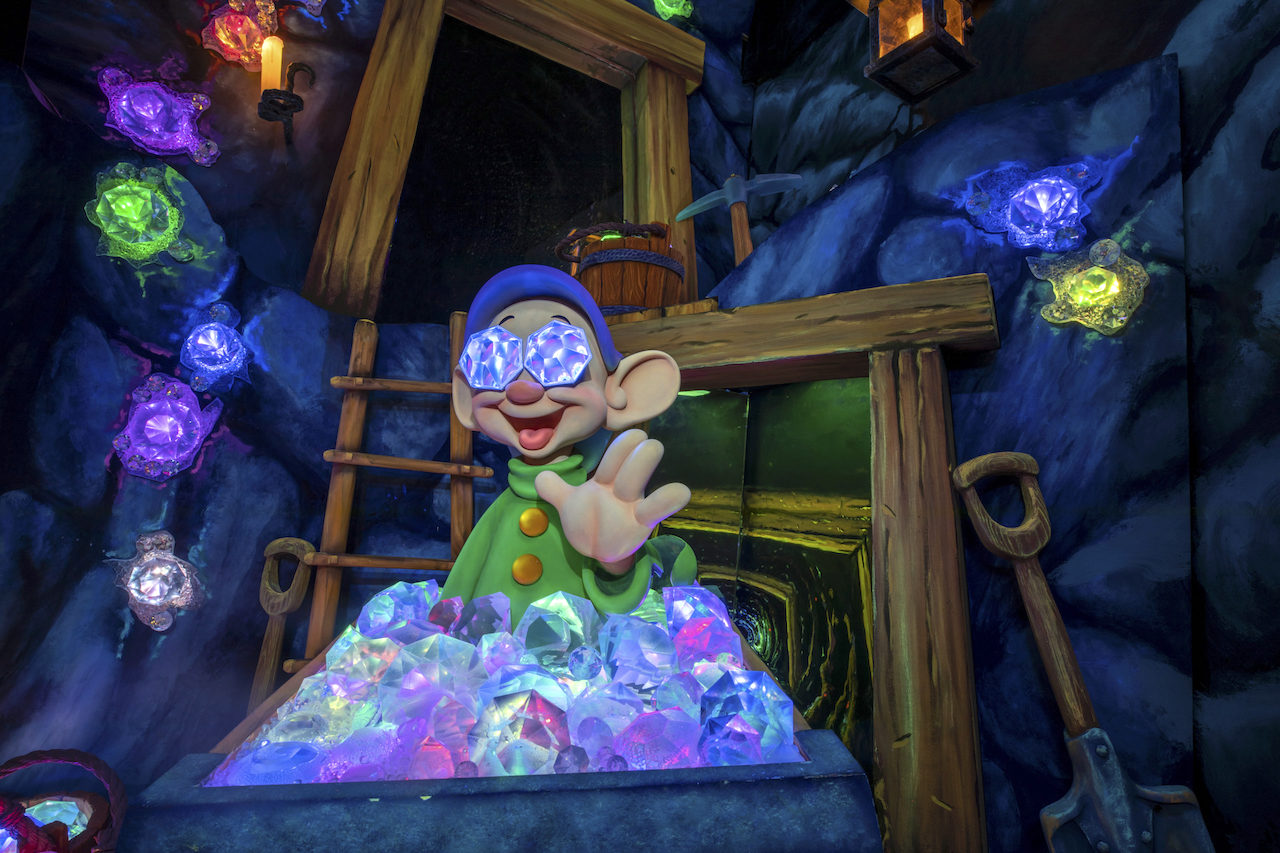
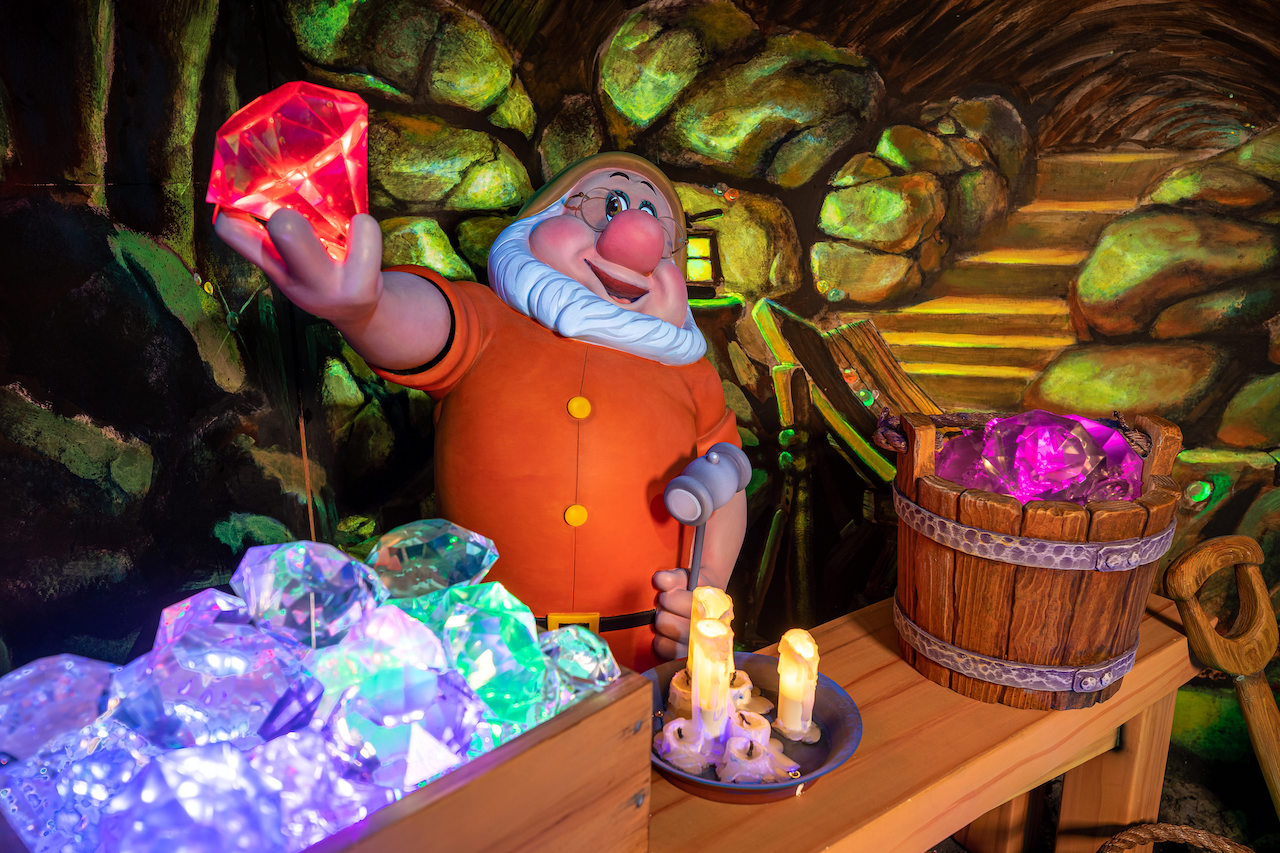
Then we make the transition back to the Queen's chamber, and we get the story points of her turning into the hag. Then we see her as the hag, getting the poison apple.
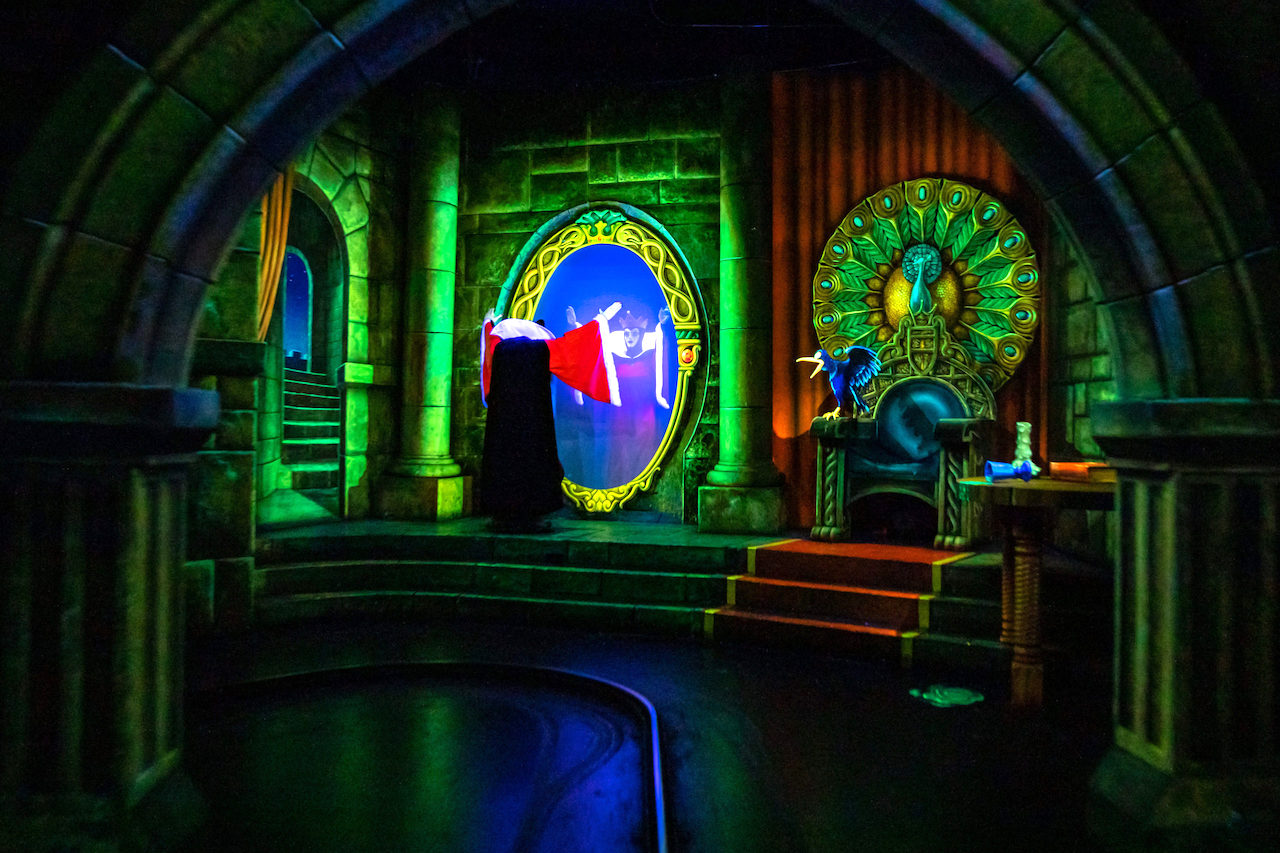
The very next scene we see Snow White biting the apple, but we see her in the magic mirror. We don't see her physically, but we see her image in the mirror. She bites the apple, the mirror smashes apart, and we immediately go to the Dwarfs chasing the hag up the hill, banishing her.
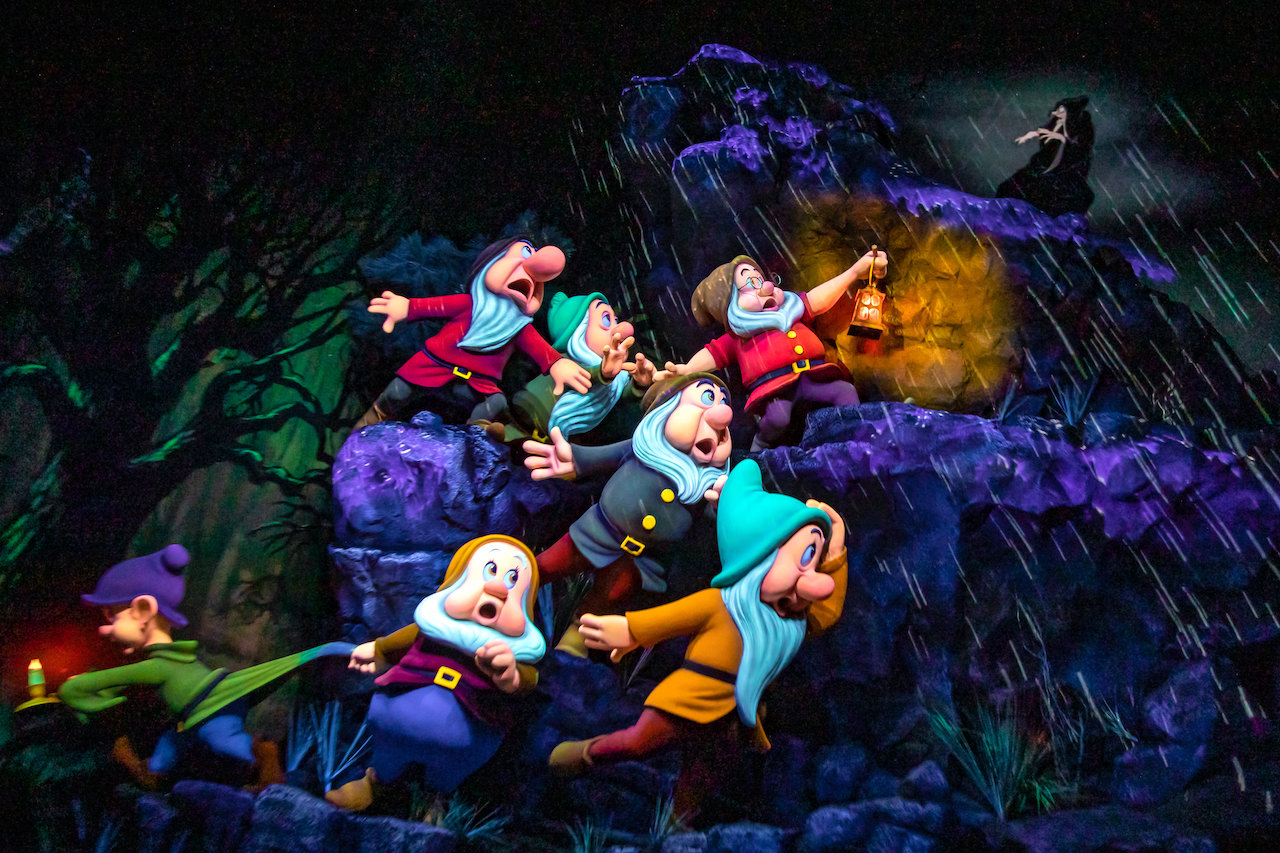
That takes us directly into the next scene, which is Prince kissing Snow White. It's a beautiful scene - I can't wait for you to see it. It's a very far-off vignette. When we start the scene, you're far away from it, and all you see is this dark room. You see the prince and Snow White and you see the rain and the clouds and thunder.
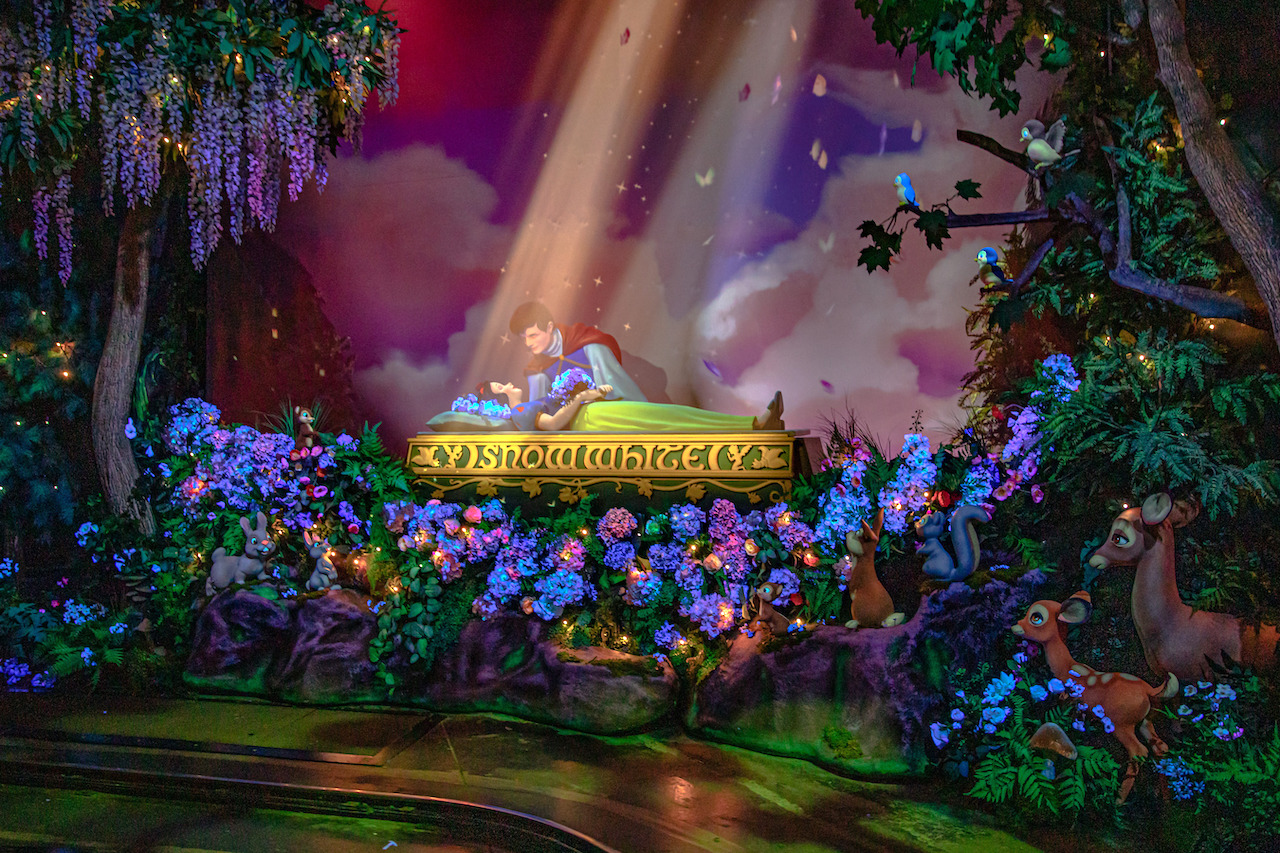
He kisses her; she wakes up, and as she does that, the clouds break, birds and butterflies fly around, the god rays come down out of the sun, and then hundreds and thousands of twinkle lights light up the entire forest, and then you see there's 50 or 60 animal friends all around. You're in the middle of this huge forest, and then you immediately turn to a storybook that tells you that with one kiss, Snow White has been awoken and the Dwarfs dance for joy.
In this storybook, we've actually digitally projected parts of the movie into it. So there's video playing within it, and then we move into the scene of Snow White with her animal friends.
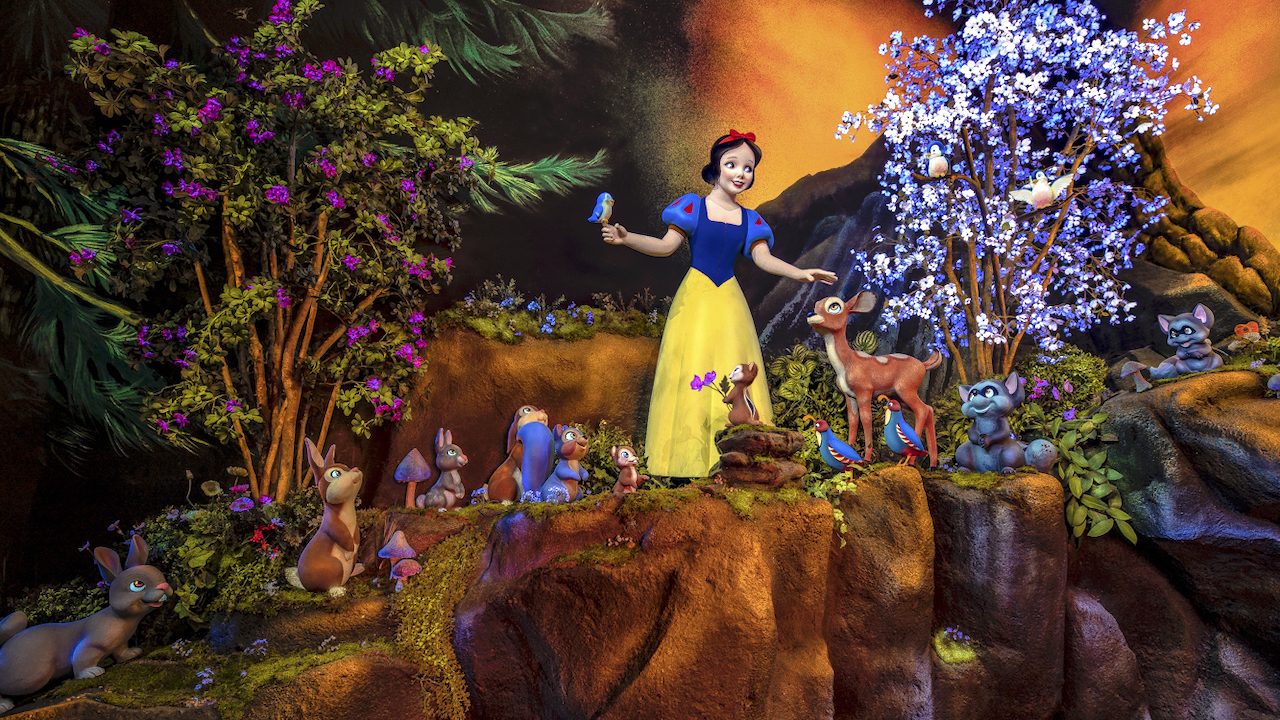
She's awoken; the prince is up on the hill with the horse. We see the castle coming through the clouds, and then the show doors open and it says, they live happily ever after. So you see, we've created a bookend show.
Robert: That sounds a lot more like the movie I remember. But I think there's something really significant with the title change. I think that communicates something completely different about the attraction and Snow White's agency within this story. Tell me a little bit about the decision to change the title of the attraction.
Dave: The attraction used to be about 75% scary, 25% happy, and we've flipped that to about 60% happy and 40% suspenseful. We've taken things out that we feel were scary - seeing skeletons hanging and being tortured. Those are scary things, and a message that we don't want to send. So we've removed all that. We've created great show sets with special effects - still very suspenseful, still inside the dungeon, still the cool sounds - but we're not trying to scare people. We're trying to engage a sense of suspensefulness as we lead up to the poison apple.
But in that change, we've created a much happier ride. So when we looked at Snow White's Scary Adventure, "Scary Adventure" didn't make sense anymore. But what was the heart of Snow White? It was her wish that one day her prince would come, right? It even starts off with the song "I'm Wishing." So we thought, okay well, what is Snow White about? It's enchantment. It's an enchanting story. So that's how we came up with the idea of Snow White's Enchanted Wish.
Robert: When you were talking about the mine scene, the first thing I thought of was Seven Dwarfs Mine Train at Walt Disney World's Magic Kingdom. How does this kind of compliment, or fit in with, or is influenced by that particular attraction, for our fans that don't just go to one Disney park but go multiple Disney parks?
Dave: I just got back from Walt Disney World and we rode Seven Dwarfs Mine Train. It's a great ride. These mines feel very different because of the way we're representing things and the way that it's scaled down.
I think they complement each other in the sense that they're both current with technology. The effects, the things that we're using, the lighting are current technology, whether it's LED lights that we're using instead of old black light fluorescence or, if it's even just the music that we're putting in hearing Heigh Ho, for instance. We brought Heigh Ho, that musical song, into this attraction where it wasn't here before. That also complements what the mine ride is doing well.
I think the biggest thing for us is it actually feels like an active mine [now]. You get to see the Dwarfs. You get to see crystals that look like they're embedded in rocks versus crystals that are glued on with hot glue under flats, which unfortunately that's what sort of it looked like in our old ride.
As Imagineers, we look around the world at other like projects, so when we were working on Snow White, we looked at the mine ride, we looked at the original Snow White from Walt Disney World, we looked at Tokyo, Shanghai and Hong Kong, and we looked at opportunities to lift technology, effects. lighting, music, BGM, voiceovers - I mean, everything. Was there any opportunity to lift something from our other parts. That obviously creates efficiency and helps drive the cost down, which is important.
Robert: This is not the only thing that's changing in Fantasyland. We just had that big change on the castle. There's some changes on the carrousel. Let's put this change in context of some of the broader changes happening in Fantasyland and Disneyland in general.
Dave: Firstly, we'll go back to what Walt Disney said, that Disneyland will never be complete right as long as there's imagination left in the world. One of the things I believe Tony Baxter had said years ago was Disneyland is not a museum. So when we look at it as Imagineers, there's always an opportunity. What can we refresh, what can we make feel of new?
We're always looking at ways to keep things fresh and new, but we're also looking at how to keep things relevant. Are kids and families still interested in what we're creating? Are we are we speaking to people today? Again, we're not a museum. It's not supposed to be Disneyland of 1955. We can still hang on to old culture, history and tradition, for sure, but we want to be relevant to today's audience, and that's one of the reasons that we made some changes in Snow White.
I mean, to be honest with you, Snow White felt like a very old, tired ride, and we wanted to pay a lot more respect to the first animated movie. And so by going there and refreshing it, it feels like we've taken a great classic ride - that still feels very classic and legacy - but we brought it up to today's world. I think to really answer the question, we're always looking at ways to keep Disneyland fresh. We don't want it to ever feel old or tired.
Update: And here is the on-ride POV video for Snow White's Enchanted Wish.
* * *
For discounts on multi-day tickets to Disneyland and Disney California Adventure, please visit our travel partner's Disneyland tickets page.
Also, we wanted you to read this article before we make our newsletter pitch, unlike so many other websites. If you appreciate that - and our approach to covering theme park news - please sign up for our free, twice-a-week email newsletter. Thank you.
TweetSnow White has always been a weird ride. The movie is an roller coaster of tones, so I never understood why it only focused on the scary parts. This should be a much better representation of the IP.
Great interview, Robert!
It's probably a lot of work to get to the people who design and build the rides, but these background stories really add depth to the appreciation of the ride.
Awesome interview! And Robert, you made some great points not just in reference to the ride...but actually related to the film (The part about the apple....that’s an interesting observation!)
Great interview, Robert!
Just watched a POV of Snow White’s Enchanted Wish, and it really is a beautiful makeover of the original attraction. The Queen/Witch is still very prevalent in the new ride, the story is more complete with the happy ending and the effects are stunning. Excellent upgrade, Imagineers! Please let the plussing continue.
I have been reading coverage on this revamped attraction, and it sounds like the most important change that was made to the ride was to slow it down just a touch. Slowing the ride ever so slightly makes it just a few seconds longer and allowed the Imagineers to pack the scenes with added details to allow the story to be more thorough and complete.
This is where the "magic" of Imagineering comes from - coming up with simple solutions to complex problems like the ride system on Soarin'. The stunning simplicity of some of Imagineering's design choices are simply amazing.
@Russell Meyer: That's what I love. So much emphasis on high-tech CGI effects and screens in rides lately but the older methods are still the best to maintain the illusion.
This article has been archived and is no longer accepting comments.
I still miss the old Snow White ride at WDW and loved it staying at Disneyland so interested how this works out. The update for Alice in Wonderland was good so this might work as well.